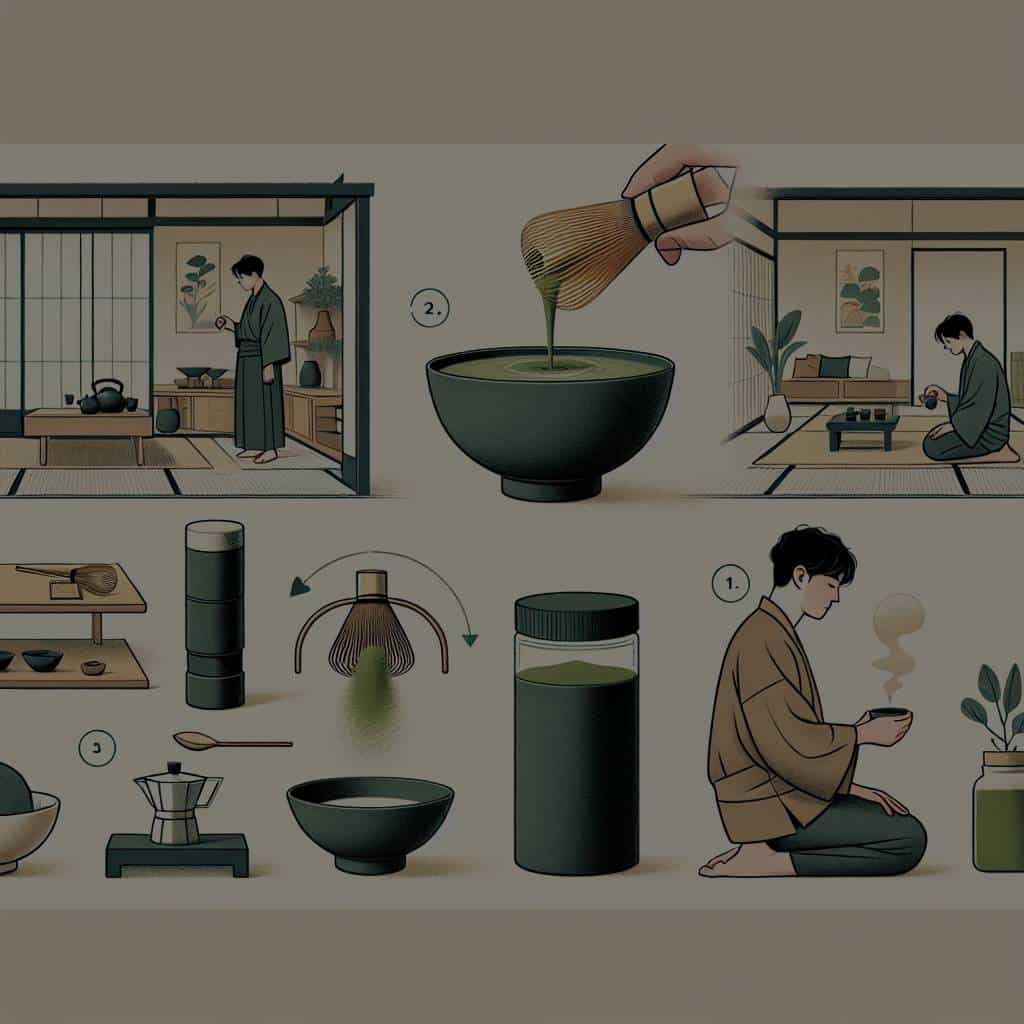How to Create an Authentic Japanese Matcha Tea Ceremony at Home?

The morning sun glimmers through your window, hinting at a day ripe with potential. What better way to start it than by immersing yourself in a centuries-old tradition from the Land of the Rising Sun? The Japanese matcha tea ceremony, a blend of culture, aesthetics, and a meditative preparation process, all culminating in a frothy cup of vibrant green tea. Let’s guide you through the journey of creating an authentic Japanese matcha tea ceremony right at the comfort of your home.
The Significance of Matcha in Japanese Culture
Before we delve into the steps of preparing a Japanese matcha ceremony, it’s crucial to understand the cultural significance of matcha in Japan. It’s not just a drink, it’s an embodiment of Zen philosophy and a means to connect with the spiritual world.
Sujet a lire : What Are the Best Practices for Crafting a Gourmet Charcuterie Board?
Matcha tea is a fine, jade-green powder produced from specially grown and processed green tea leaves. Its origins date back to the Tang Dynasty in China, but it was the Japanese who truly recognized its value and incorporated it into their daily lives and special ceremonies.
The Japanese tea ceremony, known as Chado or Sado, translates to "the way of tea." It emphasizes four principles: harmony, respect, purity, and tranquility. These principles guide every step of the ceremony and make matcha more than just a beverage. It’s a practice of mindfulness, appreciation, and a symbolic depiction of Japanese culture and philosophy.
Dans le meme genre : Can You Prepare a Gourmet Cornish Hen with a Lavender and Honey Glaze?
Necessary Utensils for the Tea Ceremony
Choosing the right utensils is essential for performing the matcha tea ceremony. Each tool has a purpose and contributes to the overall experience and aesthetics of the event. Let’s explore the key utensils necessary for conducting the ceremony at home.
-
Chawan (Tea Bowl): This is a wide, shallow bowl where the matcha tea is prepared and served. It is often made of ceramic and comes in various designs, reflecting the seasons or the mood of the occasion.
-
Chasen (Bamboo Whisk): The chasen is a whisk made from a single piece of bamboo, used to mix the matcha powder with water to a perfect froth. It usually has 80 to 120 tines, which help incorporate air into the mixture, achieving the desired frothy texture.
-
Chashaku (Bamboo Scoop): This is a thin, curved tool used to measure and scoop the matcha powder into the tea bowl.
-
Mizusashi (Cold Water Container): This container holds the cold water used to rinse the tea bowl and whisk.
It’s worth mentioning that the selection of utensils can vary depending on the time of year and the type of ceremony. However, these are the basic tools you’ll need to conduct a traditional tea ceremony at home.
The Step-By-Step Guide to Preparing a Matcha Tea Ceremony
Now that you’re acquainted with the cultural significance of matcha and have your tools ready, you’re all set to prepare your very own matcha tea ceremony. Remember, this isn’t a rushed process. It’s a time to reflect, be mindful and engage in an act of self-care.
Step 1: Preparing the Tea Room and Utensils
Begin by preparing the space where you’ll be conducting the tea ceremony. It should be clean, quiet, and conducive to tranquility. Rinse the tea bowl with hot water and warm it up. Then, rinse the bamboo whisk and scoop. Arrange all your utensils within easy reach.
Step 2: Mixing Matcha Powder and Water
Use the bamboo scoop to measure out two scoops of matcha powder into your tea bowl. Then, pour in a little hot water (just below boiling point), around 70-80ml.
Step 3: Whisking the Matcha
Take your bamboo whisk and begin to mix the matcha and water. Whisk in a zigzag or W-shaped motion until the tea is frothy, with tiny bubbles on the surface.
Step 4: Serving the Tea
Turn the tea bowl so the most beautiful part faces the guest. Then, serve.
Hosting a Matcha Tea Ceremony for Guests
If you wish to host a matcha tea ceremony for guests, remember that this is a ritual of hospitality and respect. It’s an opportunity to share a cultural experience, and it goes beyond just serving tea.
Invite your guests into the tea room and ask them to sit in the traditional seiza style (kneeling position). The host then prepares the tea following the steps outlined above. While preparing the tea, the host and guests should maintain silence, fostering an atmosphere of tranquility and mindfulness.
Once the tea is prepared, the host serves it to the guests. Each guest takes a turn to drink from the bowl, then wipes the rim before passing it onto the next person. This process is repeated until all guests have partaken of the tea.
Remember, the objective of the matcha tea ceremony is not only to enjoy a delicious cup of tea but to cultivate an atmosphere of respect, tranquility, and harmony. As a host, it’s your responsibility to ensure that these principles are upheld throughout the ceremony.
Crafting the Perfect Matcha Tea Recipe at Home
While the traditional matcha tea recipe consists of only matcha powder and hot water, you may wish to experiment with different flavors at home. Feel free to add sweeteners like honey or agave syrup, or even a splash of milk for a creamier texture. However, always remember that the true essence of matcha lies in its simplicity and subtlety.
In conclusion, embracing the tradition of the Japanese matcha tea ceremony at home can be a rewarding and enlightening experience. Whether you’re a tea enthusiast or simply looking for a new way to incorporate mindfulness into your routine, this ancient ritual offers a rich blend of culture, philosophy, and a delicious cup of tea. Take your time, be patient, and enjoy the journey of preparing matcha tea.
Matching the Mood: Setting the Atmosphere for Your Tea Ceremony
In a traditional Japanese matcha tea ceremony, the atmosphere is just as important as the tea itself. It’s about creating a sensory experience that allows you to fully immerse in the moment and connect with the Japanese culture.
The tea room, known as chashitsu, plays a significant role in setting this ambiance. It’s typically a tranquil space with a serene view, often of a garden. The decor is minimalistic, with tatami mats covering the floor and a simple scroll painting or calligraphy adorning the wall. The low ambient lighting is soft and calming.
If you don’t have a separate tea room, you can create a similar ambiance in a quiet corner of your home. The key is to keep it simple and free of clutter. Arrange a few cushions on the floor for seating and a small table to place your tea utensils.
In addition to the physical setting, playing some gentle, traditional Japanese music in the background can enhance the overall mood. You can also burn some incense for a unique sensory touch. The scent of aloeswood or sandalwood is often preferred.
In essence, creating the right mood for your tea ceremony is about simplicity, tranquility, and a deep connection with nature. It’s about fostering an environment that encapsulates the principles of Chado: harmony, respect, purity, and tranquility.
A Moment of Reflection: The Meditative Aspect of the Tea Ceremony
The Japanese tea ceremony is not merely about drinking tea, but it’s a form of meditation and an opportunity for introspection. When you’re making matcha tea, you’re encouraged to be fully present, focusing on each step of the process and the sensations associated with it.
From the act of scooping the vibrant green matcha powder into the tea bowl, to the sound of the boiling water and the mesmerizing motion of the bamboo whisk, each moment is a chance to be mindful. By slowing down and focusing on these simple actions, you can achieve a state of calmness and clarity.
During the tea ceremony, you’re also encouraged to contemplate the four principles of Chado. How can you cultivate harmony in your relationships? How can you demonstrate respect towards others? How can you maintain purity in your thoughts and actions? And how can you find tranquility amidst the chaos of life?
Therefore, engaging in a matcha tea ceremony is more than just a cultural experience. It’s a powerful mindfulness practice that can help you cultivate peace, balance, and a deeper understanding of yourself and your environment.
Conclusion: Embrace the Way of Tea
So, the next time you sip a bowl of matcha, remember that you’re partaking in a tradition steeped in Japanese culture, history, and philosophy. The Japanese tea ceremony is not just about the taste of the tea, but about the journey of preparing it, the ambiance, and the meditative experience.
Whether you’re performing the ceremony alone or hosting it for guests, remember to uphold the principles of Chado: harmony, respect, purity, and tranquility. This way, you’re not only creating an authentic Japanese matcha tea ceremony at home but also immersing yourself in a rich and enlightening cultural experience.
Creating an authentic matcha tea ceremony may seem intimidating at first, but with a little practice and patience, it can become a rewarding part of your routine. So, get your matcha bowl, bamboo whisk, and matcha powder ready, and embark on this incredible journey of self-discovery and mindfulness. Happy whisking!
